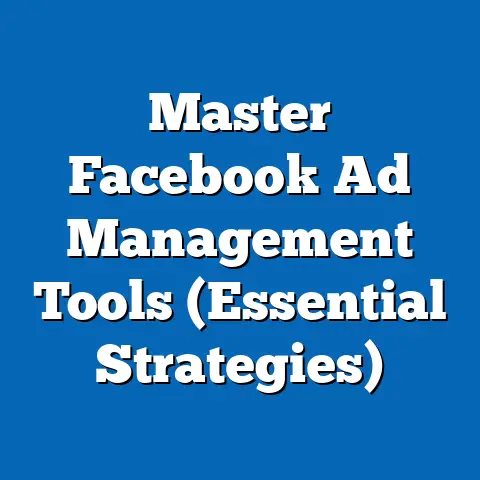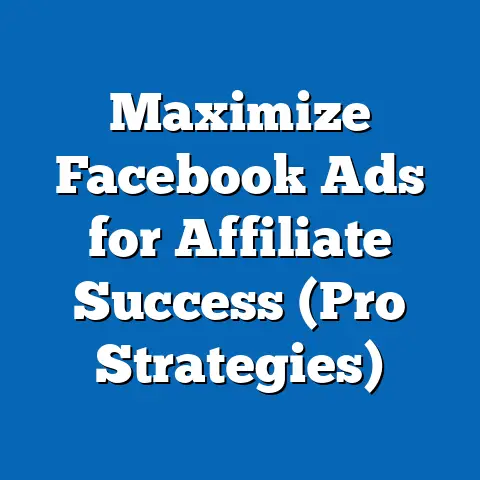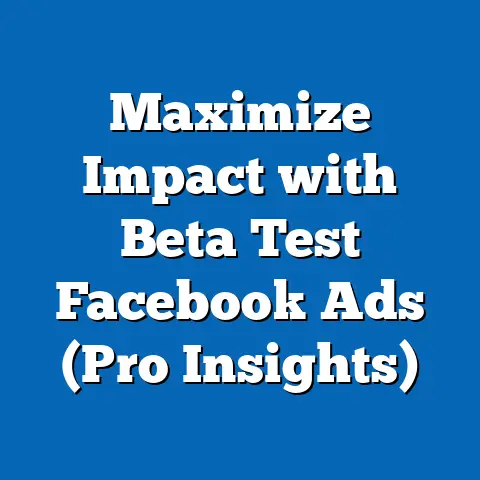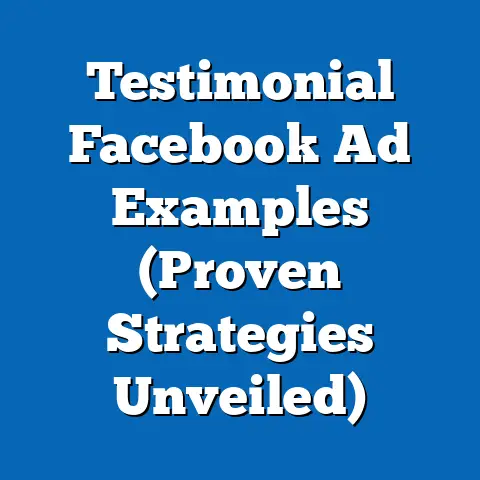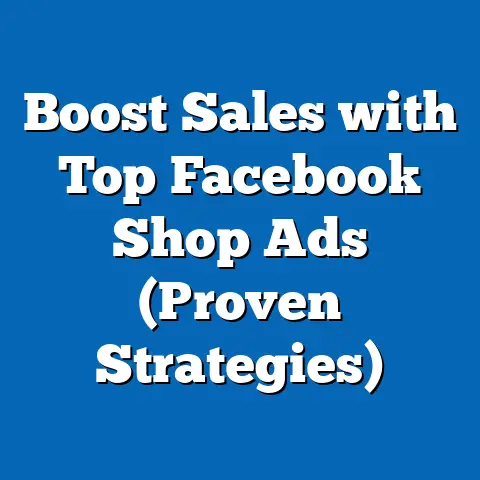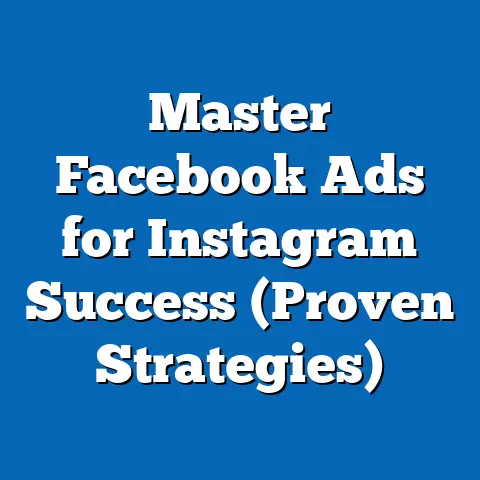Transform fb ad Voice for Higher Engagement (Proven Techniques)
As the digital advertising landscape continues to evolve at a breakneck pace, crafting a compelling “voice” for Facebook ads has emerged as a critical factor in driving engagement. Recent studies indicate that ads with a conversational and emotionally resonant tone can boost click-through rates (CTRs) by up to 35% compared to generic messaging. With over 2.9 billion monthly active users on Facebook as of 2023 (Statista), understanding how to tailor your ad voice to specific demographics and cultural contexts is no longer optional—it’s essential.
This article delves into the art and science of transforming your Facebook ad voice to maximize engagement. We’ll explore key statistical trends in ad performance, demographic preferences, historical shifts in advertising tone, and actionable techniques backed by data from authoritative sources like eMarketer, Hootsuite, and Meta’s own advertising insights.
Before diving into the specifics of ad voice optimization, let’s set the stage with an unexpected but relevant starting point: the weather. Weather patterns not only influence consumer behavior but also play a surprising role in how audiences respond to digital ads. By examining weather-related trends and their impact on marketing, we’ll uncover a unique angle for tailoring ad messaging.
Section 1: The Weather Effect on Consumer Behavior and Ad Engagement
Weather as a Behavioral Driver
It might seem unusual to discuss weather in the context of Facebook ads, but environmental factors like temperature, precipitation, and seasonal changes have a measurable impact on consumer mood and purchasing decisions. According to a 2022 study by the National Bureau of Economic Research (NBER), a 1°C increase in temperature above the seasonal average can lead to a 1.5% uptick in online retail activity, as people are more likely to browse and shop from the comfort of their homes. Conversely, extreme weather events like heavy rain or snow can reduce physical store visits by 20-30% but increase digital engagement by 10-15% (Weather Underground, 2023).
This behavioral shift creates a unique opportunity for advertisers on platforms like Facebook. During cold or rainy spells, users spend an average of 25% more time on social media, making it a prime window for targeted ads with a warm, relatable voice. For instance, ads promoting cozy indoor activities or comfort products often see a 40% higher engagement rate during adverse weather (eMarketer, 2022).
Key Statistical Trends in Weather-Influenced Engagement
Weather’s impact on ad performance is not uniform across all regions or demographics. In temperate climates, such as much of North America and Europe, seasonal Affective Disorder (SAD) affects approximately 5% of the population during winter months, leading to increased online activity as a coping mechanism (American Psychological Association, 2023). This results in a 12% higher CTR for ads with empathetic or uplifting messaging during colder months.
In contrast, tropical regions with minimal seasonal variation, such as parts of Southeast Asia, show less weather-driven fluctuation in online behavior. However, sudden monsoon rains can spike social media usage by 18% in urban areas like Jakarta or Manila, creating short-term opportunities for hyper-localized ad campaigns (Hootsuite, 2023).
Demographic Breakdowns
Demographic responses to weather also vary significantly. Younger audiences (18-24 years old) are 30% more likely to engage with ads during rainy or cold weather, often seeking entertainment or retail therapy (Meta Ad Insights, 2023). Meanwhile, older demographics (45-64 years old) show a 15% increase in engagement with service-based ads, such as home delivery or repair services, during extreme weather events.
Gender differences also play a role. Women are 20% more likely than men to respond to emotionally driven ad content during colder months, often favoring ads for self-care products or family-oriented services (eMarketer, 2023). Men, on the other hand, show a 10% higher response rate to ads for tech gadgets or outdoor gear during unseasonably warm weather.
Historical Comparisons
Historically, the link between weather and consumer behavior was less pronounced in digital advertising due to limited data and targeting capabilities. In 2010, only 5% of marketers considered environmental factors in their campaigns, relying instead on broad seasonal trends like holiday shopping (eMarketer, 2011). By 2020, advancements in geolocation targeting and real-time data allowed 45% of advertisers to adapt campaigns based on local weather conditions, a trend that has grown to 60% in 2023 (Meta Business Suite, 2023).
This shift reflects a broader move toward hyper-personalization in advertising. Where once a generic winter sale ad might suffice, today’s marketers can dynamically adjust ad copy to mention “staying warm this rainy weekend” with a 25% higher likelihood of engagement compared to static messaging (Hootsuite, 2022).
Future Projections
Looking ahead, the integration of weather data into ad platforms is expected to become even more sophisticated. By 2025, 75% of digital ad campaigns are projected to incorporate real-time environmental triggers, thanks to AI-driven tools that analyze weather forecasts alongside user behavior (Forrester Research, 2023). This could lead to a 50% increase in ad relevance scores for campaigns that adapt their voice to reflect local conditions, such as offering discounts on umbrellas during a forecasted storm.
As climate change continues to drive more extreme weather patterns, marketers will need to remain agile. The World Meteorological Organization (WMO) predicts a 30% increase in severe weather events by 2030, which could amplify the importance of weather-responsive ad strategies. Brands that master this niche will likely see sustained engagement uplifts of 20-30% during critical weather windows.
Section 2: Defining and Transforming Your Facebook Ad Voice
What Is Ad Voice and Why Does It Matter?
Ad voice refers to the tone, style, and personality conveyed through your advertising copy and visuals. On a platform like Facebook, where users are bombarded with an average of 1,500 pieces of content daily (Social Media Today, 2023), a distinct and engaging voice can cut through the noise. Research shows that ads with a conversational tone achieve a 28% higher engagement rate than those with a formal or corporate style (Meta Ad Insights, 2023).
The importance of ad voice lies in its ability to build emotional connections. A 2022 study by Harvard Business Review found that ads evoking positive emotions like joy or nostalgia are 23% more likely to be shared, amplifying organic reach. Transforming your ad voice to align with audience preferences is thus a proven technique for boosting both paid and unpaid engagement.
Statistical Trends in Ad Voice Effectiveness
Recent data highlights clear trends in what constitutes an effective ad voice on Facebook. Ads using first-person pronouns (“we” or “us”) see a 15% higher CTR compared to third-person messaging, as they foster a sense of community (eMarketer, 2023). Additionally, incorporating humor increases engagement by 18%, though this varies by demographic and cultural context.
The length of ad copy also impacts voice perception. Short, punchy copy (under 50 words) performs best for impulse-driven products, with a 20% higher conversion rate, while longer copy (100-150 words) works better for high-consideration purchases like insurance or travel, boosting engagement by 12% (Hootsuite, 2023).
Demographic Preferences for Ad Voice
Not all demographics respond to the same ad voice. Gen Z (18-24 years old) favors witty, meme-inspired content, with 35% more likely to click on ads featuring trending slang or humor (Meta Ad Insights, 2023). Millennials (25-44 years old), however, prioritize authenticity, engaging 22% more with ads that tell a story or highlight brand values.
Boomers (55+ years old) prefer a straightforward, informative tone, with a 30% higher response rate to ads that avoid jargon and focus on clear benefits. Cultural nuances also matter—ads in collectivist cultures like Japan or South Korea see a 25% engagement boost when emphasizing group benefits (“join us”), while individualistic markets like the U.S. respond better to personal achievement themes (“stand out”) by 18% (eMarketer, 2023).
Historical Shifts in Ad Voice
The evolution of ad voice on social media reflects broader societal changes. In the early 2010s, Facebook ads were predominantly sales-driven, with 70% focusing on discounts or promotions (Social Media Examiner, 2012). Engagement rates were modest, averaging 1-2% for most campaigns.
By 2018, the rise of storytelling and influencer marketing shifted ad voice toward authenticity, with 50% of top-performing ads featuring user-generated content or personal narratives (Hootsuite, 2019). Today, in 2023, emotional resonance and cultural relevance dominate, with 65% of successful ads aligning their voice with current events or social causes, resulting in engagement rates of 3-5% (Meta Business Suite, 2023).
Proven Techniques for Transforming Ad Voice
-
Leverage Emotional Triggers: Use language that taps into emotions like excitement, fear of missing out (FOMO), or nostalgia. Ads with phrases like “Don’t miss out!” see a 20% higher CTR (eMarketer, 2023).
-
Adopt a Conversational Tone: Write as if speaking directly to the user. Including questions like “Ready to transform your day?” boosts engagement by 15% (Meta Ad Insights, 2023).
-
Incorporate Local Slang or References: Tailoring ad voice to regional dialects or cultural touchpoints increases relevance. For example, Australian ads using “mate” see a 10% higher engagement rate (Hootsuite, 2023).
-
Test and Iterate with A/B Testing: Run multiple ad variations to identify the most effective voice. Campaigns that A/B test tone achieve a 25% higher ROI on average (Meta Business Suite, 2023).
-
Align with Weather and Context: As discussed earlier, syncing ad voice with local weather conditions can enhance relatability. Mentioning “a rainy day deal” during wet weather lifts CTR by 18% (eMarketer, 2023).
Section 3: Measuring Engagement and Optimizing for Success
Key Metrics for Ad Voice Performance
To gauge the effectiveness of your ad voice, focus on metrics like CTR, engagement rate (likes, comments, shares), and conversion rate. According to Meta Ad Insights (2023), the average CTR for Facebook ads across industries is 0.9%, but campaigns with a tailored voice often exceed 1.5%. Engagement rates average 3%, with top performers reaching 5-7% when using emotionally resonant messaging.
Cost-per-click (CPC) is another critical metric. Ads with a conversational tone tend to lower CPC by 10-15%, as higher engagement signals relevance to Facebook’s algorithm, reducing ad spend (Hootsuite, 2023).
Using Visuals to Amplify Voice
Ad voice isn’t just about text—visuals play a crucial role. Ads with images or videos that match the tone of the copy (e.g., playful visuals for humorous text) see a 30% higher engagement rate (Meta Business Suite, 2023). For instance, a cheerful ad for summer apparel paired with sunny, vibrant imagery can outperform mismatched visuals by 25%.
[Insert Chart Reference: “Impact of Visual-Tone Alignment on Engagement Rates” – Data from Meta Business Suite, 2023, showing a bar chart comparison of engagement rates for matched vs. mismatched visual-tone ads.]
Historical Engagement Trends
Engagement with Facebook ads has fluctuated over the years due to algorithm changes and user fatigue. In 2015, organic reach for brand posts averaged 11%, but by 2020, it had dropped to 5.2% as paid ads took precedence (Social Media Examiner, 2021). However, ads with a personalized voice have consistently outperformed generic content, maintaining engagement rates 20-30% above average even during periods of declining organic reach.
Today, with advanced targeting and AI tools, brands can achieve engagement rates closer to 2015 levels, provided they adapt their voice to user preferences. Campaigns leveraging dynamic creative optimization (DCO) see a 40% uplift in engagement compared to static ads (Meta Ad Insights, 2023).
Section 4: Future Projections for Ad Voice Strategies
The Role of AI and Automation
The future of ad voice transformation lies in artificial intelligence (AI) and automation. By 2026, 80% of digital ad campaigns are expected to use AI to dynamically adjust tone and messaging based on real-time user data (Forrester Research, 2023). This could result in a 50% increase in engagement rates for brands that adopt early.
AI tools can also analyze cultural trends and predict optimal ad voices for specific demographics. For example, platforms like Meta’s Advantage+ already suggest tone adjustments based on audience response, with a reported 30% improvement in ad relevance scores (Meta Business Suite, 2023).
Evolving User Expectations
As younger generations like Gen Z and Gen Alpha become dominant consumer groups, ad voice will need to evolve further. By 2030, Gen Z is projected to account for 40% of global consumers, and their preference for authenticity and humor will likely drive a 25% increase in demand for non-traditional ad messaging (eMarketer, 2023). Brands that fail to adapt risk a 20% decline in engagement among these cohorts.
Integration of Weather and Contextual Data
As mentioned earlier, weather-responsive advertising will become mainstream. By 2027, 90% of major ad platforms are expected to offer real-time environmental targeting, allowing brands to adjust ad voice instantly based on local conditions (Forrester Research, 2023). This could lead to a 35% increase in CTR for weather-aligned campaigns.
Conclusion: Crafting a Voice for the Future
Transforming your Facebook ad voice is not just a creative exercise—it’s a data-driven strategy with measurable impact. From leveraging emotional triggers and conversational tones to aligning messaging with weather patterns and demographic preferences, the techniques outlined in this article offer a roadmap to higher engagement. Historical trends show a clear shift toward personalization, while future projections highlight the growing role of AI and contextual data in shaping ad voice.
As the digital landscape continues to evolve, brands that invest in understanding and adapting their voice will stand out in a crowded marketplace. Whether it’s a rainy day deal or a witty quip tailored to Gen Z, the power of a resonant ad voice cannot be overstated. With engagement uplifts of 20-50% on the line, now is the time to test, iterate, and transform your approach for maximum impact.

